Consultation Shows 66% Have Negative View on Cycleway 9
TfL publishes details of responses and monitoring report on scheme
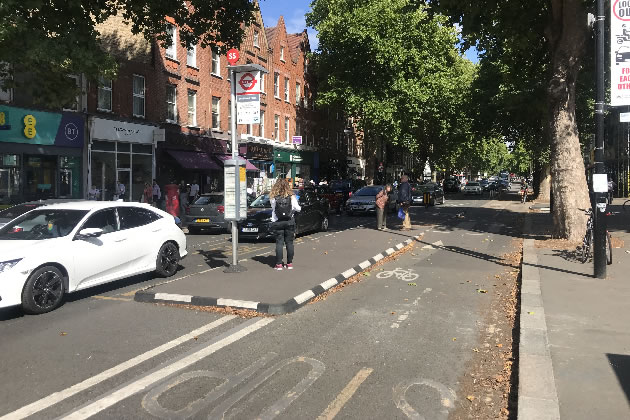 Pedestian safety particularly at bus islands was the most mentioned concern
Pedestian safety particularly at bus islands was the most mentioned concern
August 29, 2023
Two thirds of people who responded to a question about the cycleway on Chiswick High Road have said that they believe it has had a negative impact overall.
The responses were made to a consultation held by Transport for London (TfL) on the latest version of the segregated cycle route which was held between 4 October 2022 and 3 April 2023. 69% of respondents said they believed changes should be made to the existing scheme.
Over 5,292 people and 18 stakeholder groups responded with 78% describing themselves as local residents.
At the same time as the publication of the report into the consultation, TfL has released a Monitoring Report showing data it has collected on the impact of the cycleway on traffic, bus times and road safety. This concludes that the scheme has not led to a measurable deterioration in road safety and increased the number of ‘cycle kilometres’ on the High Road significantly.
When asked about their main mode of transport, 34% of respondents said that they walked with 30% saying they cycled and 20% that they used the car for personal trips. Only 11% said that buses were their primary means of getting around.
31% of respondents said that they cycle more with 26% saying that they cycle less. The net figures suggest that there has been an increase in walking but a reduction in driving and use of public transport on the High Road since the cycleway opened.
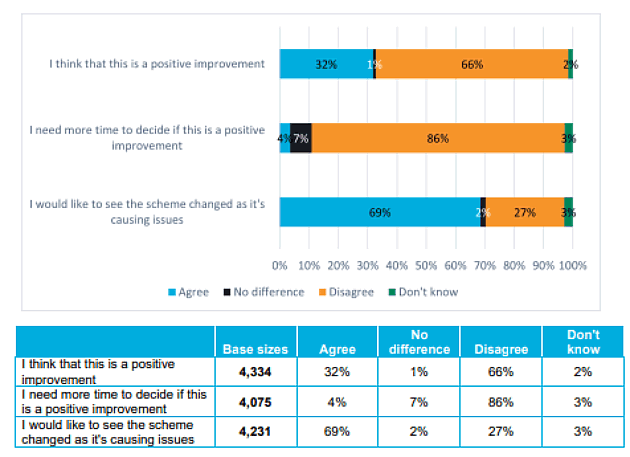
Overall opinions about the Cycleway. Source: TfL
In Spring 2021, TfL installed automatic monitoring cameras at Heathfield Terrace and Chiswick High Road (west of Chiswick Lane) to count the number of cyclists using the new cycle lane. Before the cameras were installed, TfL counted the number of people cycling on Chiswick High Road manually once a year. In spring 2019, before the experimental changes to Chiswick High Road were built, manual counts showed that there were 2,114 people cycling here during the week. By spring 2022, this had risen to 2,592 an increase of 23 per cent.
TfL has measured the total distance travelled by all cyclists in a particular area or ‘Cycle Kilometres’. It says this gives a more complete picture of cycle use and this shows a 47% increase between 2021 and 2023.
60% of respondents said that they felt less safe walking or cycling on the High Road than before with 32% saying they believed they were safer. In a later section of the survey in which respondents were allowed to give more detailed replies, the largest number expressed concern about pedestrian safety particularly at bus stop by-passes, followed by concerns about dangerous cycling such as speeding and ignoring traffic lights and then reservations about cyclist safety when vehicles emerge from side roads.
Age Concern Chiswick commented that the new bus stop bypasses are dangerous for older people since ‘cyclists often do not stop for pedestrians’ and added that there can also be delays to buses and ambulances.
Pocklington Lodge Tenants’ Association stated that visually impaired people find it more difficult to access bus services due to the bus stop by-passes as it is difficult for them to be sure it is safe to cross the cycle lanes to the bus stop. The Goldhawk Road/Chiswick High Road junction was given as a particular example.
The Bedford Park Bicycle Club commented that the scheme had been an ‘excellent improvement’, highlighting that children are now able to safely cycle to school. Suggested that permanent signage be added to instruct motorists to look both ways at junctions which cross the cycle
lane.
The monitoring report issued by TfL shows that the number of collisions involving cyclists as fallen since the safety upgrades were made to the cycleway on Chiswick High Road earlier this year, although it is acknowledged that it is too early to reach a firm conclusion on whether this is a permanent trend. Most serious collisions on the Cycleway have occurred on the King Street section particularly near Welte Road which is not covered by the report.
TfL says, “Now that the improvements to the scheme have been fully completed, the collision rate has decreased significantly compared to the time before the experimental scheme was introduced and compared to the original experiment. We will of course need to collect more data, but we are encouraged by these initial indications.”
The report continues, “We’ve looked at whether there have been any collisions between pedestrians and cyclists on Chiswick High Road since the scheme was originally introduced in December 2020. There has only been one collision recorded that involved a pedestrian and a cyclist and this happened while we were building improvements to the scheme, and when the cycle lane (and therefore the bus stop bypass) was closed. There have been no pedestrian collisions recorded since the full improvements were completed.”
Only 10% of respondents felt that traffic was flowing more freely with 74% saying that congestion had increased and 61% saying it was more difficult to get to shops on the High Road.
The monitoring report included data on bus times which showed that performance had deteriorated particularly eastbound on the High Road and northbound on Chiswick Lane. The average journey time during the weekday (7am – 7pm) had increased by less than a minute per kilometre eastbound and 1.7 minutes on Chiswick Lane northbound.
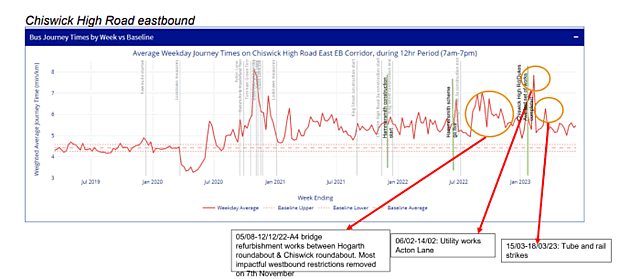
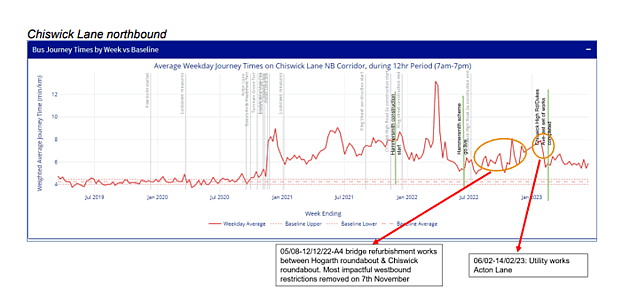
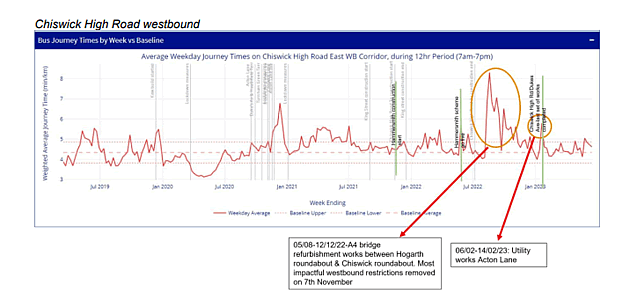
TfL said, “The most recent changes we made to the scheme have certainly helped buses to run more reliably, although we do need to continue to look at what could be done to help buses in the eastbound direction to run more reliably.”
For the bus gate by Acton Lane the report states that buses gain an average of 10 seconds every time they use it and that journey times for other vehicles have not changed significantly since 2019 with traffic volumes down on Sutton Lane North, Heathfield Terrace and Heathfield Gardens. The report concludes that it is ‘important that the bus lane be retained.’
The Licensed Taxi Drivers’ Association said that many of its members actively avoid Chiswick High Road adding, “Not only does this impact on licensed taxi drivers by making it more difficult and stressful to do their job, this also results in a lack of taxis available for members of the public in the area, thus depriving them of a safe and efficient transport option along Chiswick High Road.”
18% believed that air quality had improved with half of saying they believed air pollution had got worse and 55% saying that noise pollution had increased. No figures on pollution were provided in the monitoring report.
In a question addressed to local businesses only, 53% said they believed that the impact on trade of Cycleway 9 was negative with just 10% expressing the view that it had boosted their revenues. 44% said that it had made receiving deliveries more difficult and 45% said customers had reported to them that they had increased difficulty parking with just 15% saying the opposite.
The London Cycling Campaign (LCC) provided a structured email for its members to use and 378 people submitted responses this way. Because the questions were not identical to the ones in the original survey and demographic details were not provided, TfL did not include these responses in the ‘closed’ section of the questionnaire i.e. the overall opinion on the scheme but did take them into account for the open section. Responses by LCC members direct to the survey were counted.
The decision on the future of Cycleway 9 based on the consultation feedback and monitoring data supplied by TfL will be made by Hounslow Council.
TfL says, “Once Hounslow has decided on the way forward we will look in detail at the issues people raised in their written comments to the consultation, and reply to these in detail.”
These responses will be published in a subsequent report.
Like Reading Articles Like This? Help Us Produce More This site remains committed to providing local community news and public interest journalism. Articles such as the one above are integral to what we do. We aim to feature as much as possible on local societies, charities based in the area, fundraising efforts by residents, community-based initiatives and even helping people find missing pets. We've always done that and won't be changing, in fact we'd like to do more. However, the readership that these stories generates is often below that needed to cover the cost of producing them. Our financial resources are limited and the local media environment is intensely competitive so there is a constraint on what we can do. We are therefore asking our readers to consider offering financial support to these efforts. Any money given will help support community and public interest news and the expansion of our coverage in this area. A suggested monthly payment is £8 but we would be grateful for any amount for instance if you think this site offers the equivalent value of a subscription to a daily printed newspaper you may wish to consider £20 per month. If neither of these amounts is suitable for you then contact info@neighbournet.com and we can set up an alternative. All payments are made through a secure web site. One-off donations are also appreciated. Choose The Amount You Wish To Contribute. If you do support us in this way we'd be interested to hear what kind of articles you would like to see more of on the site – send your suggestions to the editor. For businesses we offer the chance to be a corporate sponsor of community content on the site. For £30 plus VAT per month you will be the designated sponsor of at least one article a month with your logo appearing if supplied. If there is a specific community group or initiative you'd like to support we can make sure your sponsorship is featured on related content for a one off payment of £50 plus VAT. All payments are made through a secure web site. |